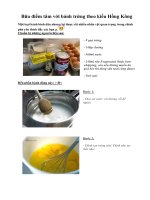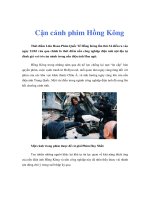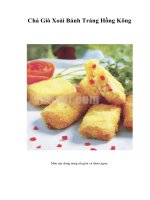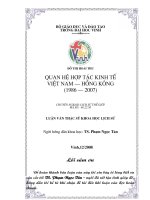rough guides directions hong kong & macau
Bạn đang xem bản rút gọn của tài liệu. Xem và tải ngay bản đầy đủ của tài liệu tại đây (4.84 MB, 208 trang )
Rough Guide DIRECTIONS
ROUGHGUIDES
Hong Kong
& MacauHong Kong
& Macau
DIRECTIONS
WRITTEN AND RESEARCHED BY
Jules Brown and David Leffman
NEW YORK • LONDON • DELHI
www.roughguides.com
2
Your e-book Reader has many options for viewing and navigating
through an e-book. Explore the dropdown menus and toolbar at
the top and the status bar at the bottom of the display window to
familiarize yourself with these.
The following guidelines are provided to assist users who are not
familiar with PDF files. For a complete user guide, see the Help menu
of your Reader.
• You can read the pages in this e-book one at a time, or as two
pages facing each other, as in a regular book. To select how you’d
like to view the pages, click on the View menu on the top panel
and choose the Single Page, Continuous, Facing or Continuous
– Facing option.
• You can scroll through the pages or use the arrows at the top
or bottom of the display window to turn pages. You can also
type a page number into the status bar at the bottom and be
taken directly there. Or else use the arrows or the PageUp and
PageDown keys on your keyboard.
• You can view thumbnail images of all the pages by clicking on the
Thumbnail tab on the left. Clicking on the thumbnail of a particular
page will take you there.
• You can use the Zoom In and Zoom Out tools (magnifying glass)
to magnify or reduce the print size: click on the tool, then enclose
what you want to magnify or reduce in a rectangle. To move
around the page use the Hand tool.
• To reset the page display size, click on one of the icons that looks
like a paper sheet and try different page display sizes. This option
is also available from the View menu.
• To search for a word in the document, click on the Find tool
(binoculars) and type in the word you are looking for.
• Some versions of e-book Readers, might allow you to bookmark,
highlight and underline text in your e-book and add notes or com-
ments. Check the menu bar and tool icons to see if these options
are available in your reader.
For more tips, check out Adobe’s frequently asked questions for
e-book users by clicking
here.
Tips for reading this e-book
CONTENTS
Introduction 4
Ideas 9
The big six sights 10
Restaurants 12
Day-trips 14
Colonial Macau 16
Temples 18
Festivals 20
Shopping 22
Food and drink 24
Health 26
Wealth 28
Hong Kong islands 30
Recreation 32
Markets 34
Museums 36
Bars and clubs 38
Parks 40
On the move 42
Colonial Hong Kong 44
Traditional Hong Kong 46
Places 49
Hong Kong Island: Central and
the Peak 51
Hong Kong Island: Mid-Levels and
Western 65
Hong Kong Island: Wan Chai,
Causeway Bay and Happy Valley 74
Hong Kong Island: the south
side and east coast 84
Kowloon: Tsim Sha Tsui 92
Kowloon: Yau Ma Tei and
Mong Kok 104
The New Territories 109
Lantau 121
Other islands 127
Macau 133
Accommodation 147
Hostels, guesthouses and hotels 149
Essentials 157
Arrival 159
Information 160
City transport 160
Communications 162
Entertainment 163
Directory 166
Chronology 169
Language 173
small print & Index 185
Colour maps
Chapter Locator Map
Hong Kong
Hong Kong Island and Kowloon
Hong Kong Transit System
Contents
4
Contents
Introduction
INTRODUCTION
Facing each other across
the Pearl River estuary,
Hong Kong and Macau
offer the visitor an excit-
ing yet easy entry into the
Chinese world. Colonies
of Britain and Portugal
respectively until they
were returned to mainland
China in the 1990s as Special Administrative Regions
(SARs), today they seek to establish fresh identities for
themselves. While evidence of their colonial past lingers
in buildings, languages, food and hi-tech infrastructure,
the essentially Chinese heritage underpinning it all is
becoming increasingly apparent.
Introduction to
Hong Kong
and Macau
̆ Incense spirals, Man Mo Temple, Hollywood Road
Hong Kong’s famously futuristic
architecture has long set the
standard for similar cityscapes
rearing up all over Asia, yet its
signature harbourside skyline
is still the most strikingly
beautiful of its kind. There’s
also a broad mix of architectural
styles here, encompassing
Central’s soaring IFC2 tower,
Mong Kok’s ramshackle
town-housing, traditional clan
Contents
Introduction
INTRODUCTION
5
̄ Approach to the Ten Thousand Buddhas Monastery, Sha Tin
villages in the New Territories
and the centuries-old temples
which are dotted around. The
accompanying markets and
streetlife are compellingly
frenetic, while the shopping
– though no longer a bargain
– offers the chance to directly
compare a vast range of products
sold everywhere from open-air
stalls to hi-tech malls. Hong
Kong is also one of the best places
in the world to eat Cantonese
food, while the territory’s
Western influence means there’s
a plentiful selection of bars and
nightspots. Surprisingly, Hong
Kong’s outlying areas remain
fairly undeveloped, with a
countryside encompassing
beaches, rugged hills, wild
coastline and islands – although
none of it especially remote
– where you can escape the
pace and claustrophobia of the
downtown areas. Hong Kong’s
only real downside is that the
overwhelming commercialism
and consumption make it hard
to engage with the underlying
Chinese culture – though
you can glimpse it at Happy
Valley’s horseraces, Mong
Kok’s Bird Market or simply
by watching early-morning tai
chi practitioners going through
their routines in Kowloon Park.
Cultural barriers also drop at
the several annual Chinese
festivals sprinkling the calendar
– Chinese New Year, the Dragon
Boat Races and Cheung Chau
When to visit
Hong Kong and Macau are subtropical, which means generally humid
conditions through the year. From December to February is the coolest
period (16ºC), though usually dry; temperatures rise from March through
to May (23ºC) and rainfall increases; while from June until September the
weather is steaming hot and extremely wet (29ºC), often with fearsome
typhoons (from the Chinese tai fung – “big wind”), whose storms affect
sea traffic. Tourist levels are pretty even year-round, though it’s best to
book in advance during June’s dragon boat races, and Chinese New Year
in January or February.
INTRODUCTION
6
Contents
Introduction
Bun Festival are the liveliest
– when even visitors will find it
hard not to become caught up
in the action.
Smaller and more visually
attractive than its neighbour,
Macau is also ethnically Chinese,
but while all the temples and
festivals of southern China are
reproduced here, they’re not
the main reason for a visit.
Instead, Macau’s charm rests
on a substantial quantity of old
Portuguese churches, forts and
streets, which lend the place
a laid-back, colonial-tropical
ambiance. Macau’s tiny scale also
means you can see just about
everything on an easy day-trip
from Hong Kong, while its
superb food marries Portuguese,
Chinese, Goan, Brazilian and
African in uences, all washed
down with Portuguese port and
brandy. As far as the Chinese
are concerned, however, Macau’s
main appeal is in its many casinos
– the only place on Chinese
territory where they are legal
– which draw in swarms of
punters from Hong Kong and
mainland China.
̄ Trinket shop, Wan Chai
̆ Fish market, Lantau
INTRODUCTION
Contents
Introduction
̄ One Peking Road, Kowloon
Hong Kong and Macau
AT A GLANCE
̆ Tram, Wan Chai
New Territories
Studded with a handful of modern,
functional New Towns, the New
Territories also hide a few tradi-
tional settlements and a surprising
wealth of wild countryside, hiking
trails and beautiful scenery.
Hong Kong Island
From Central’s bars, restaurants
and waterfront skyscrapers, to
views from the Peak, smoky
temples, cruises around Aberdeen
harbour and relaxing on Shek O
beach, Hong Kong Island keeps
you entertained day and night.
Kowloon
Shopping is king in Kowloon:
Nathan Road’s stores stock the
latest model of every conceivable
electronic gadget, from mobile
phones to cameras and comput-
ers, while specialist markets trade
in jade, songbirds, goldfish and
clothes.
INTRODUCTION
Contents
Introduction
̆ Man on bike, Tai O, Lantau
8
̆ Boats, Cheung Chau harbour
Other islands
Easy walking trails to rocky
headlands and tiny beaches are
the main attractions of the small,
laid-back islands of Cheung Chau,
Peng Chau and Lamma – along
with some excellent restaurants
specializing in fresh seafood.
Macau
An easy day-trip from Hong Kong,
with an elegant quarter of old
Portuguese churches, squares and
houses, and plenty of restaurants
serving unique Macanese food
– plus a host of crowded, noisy
casinos.
̆ Largo do Senado, Macau
Lantau
Hong Kong’s largest island offers
plenty of outdoor escapes, along
with a Disneyland, the unusual
fishing village of Tai O and one
of the world’s largest Buddha
statues.
Ideas
Contents Ideas
Ideas
Contents Ideas
̆ São Paulo facade
Macau’s most famous colonial Portuguese
building, though only the intricately carved
stonework shell survived a fi re in 1835.
P.136 Ī MACAU
̆ Big Buddha at Po Lin
Religion writ large at this huge bronze
statue, which sits serenely between Lantau’s
peaks.
P.126 Ī LANTAU
Hong Kong and
Macau are superb
places to soak
up atmosphere
as you wander,
but there’s also
a handful of key
sights which form
the core of most
tourist itineraries.
Whether it’s close-
ups of modern
architecture,
sweeping
views, iconic religious
monuments or simply
sunbathing on a sandy
beach, Hong Kong and
Macau have something to
offer at every turn.
10
The big six sights
Contents Ideas
̆ Harbour at night
Central’s futuristic skyline is one of the
world’s great cityscapes, especially when lit
up at night.
P.54 Ī HONG KONG ISLAND:
CENTRAL AND THE PEAK
̄ Star Ferry
This evocative ride across Victoria Harbour
allows water-level views of shipping activity,
framed by Central’s hi-tech towers.
P.51 Ī HONG KONG ISLAND:
CENTRAL AND THE PEAK
̆ Shek O beach
One of the nicest stretches of sand in Hong
Kong, overlooked by a beautiful granite
headland.
P.90 Ī HONG KONG ISLAND:
THE SOUTH SIDE AND EAST
COAST
̄ View from the Peak
Almost all of Hong Kong is visible from
Victoria Peak, with a staggering view north
across the harbour, Kowloon and into the
New Territories.
P.59 Ī HONG KONG ISLAND:
CENTRAL AND THE PEAK
11
Contents Ideas
Many of Hong
Kong and Macau’s
restaurants have an
atmosphere every
bit as good as their
food, whether they
are formal Chinese
or Macanese
institutions, one
of the many
establishments specializing
in foreign cuisines, street
stalls with basic but
expertly cooked snacks, or
tiny cafés whose modest
furnishings completely bely
their huge reputations.
12
Restaurants
̆ Macanese restaurants
One of the perks of a trip to Macau is the
chance to eat at one of the many restaurants
serving seafood in the Macanese manner
P.144 Ī MACAU
̆ The Chippy
The British may have relinquished Hong
Kong, but their culinary infl uence remains in
nostalgic servings of battered cod ‘n’ chips
at The Chippy.
P.61 Ī HONG KONG ISLAND:
MID-LEVELS AND WESTERN
Contents Ideas
̄ Lin Heung Lau Teahouse
The Chinese describe good restaurants as
being “hot and noisy”, and you won’t fi nd a
better example than this legendary teahouse
in Sheung Wan.
P.72 Ī HONG KONG ISLAND:
MID-LEVELS AND WESTERN
̆ Yung Kee
Smart but not especially formal Cantonese
restaurant in Central, famous for its roast
meats – especially the crispy-skinned goose.
P.62 Ī HONG KONG ISLAND:
CENTRAL AND THE PEAK
̄ Jumbo Floating Restaurant
As gaudy as a fairground, this shamelessly
pretentious, multi-level restaurant serves
only average food but provides an unforget-
table dining experience.
P.90 Ī HONG KONG ISLAND:
THE SOUTH SIDE AND EAST
COAST
̆ Lord Stowe’s Bakery
This humble, open-fronted bakery in
Macau’s quiet Coloane Village produces
beautifully fragrant Portuguese baked
custard tarts.
P.145 Ī MACAU
13
Contents Ideas
If Hong Kong’s
downtown areas
become too
claustrophobic,
there are plenty
of day-trips
possible, out to
where mountains,
rugged coastlines and
beaches predominate: you
might even come across
a few rare animals and
birds. Hong Kong also
boasts two theme parks,
easily reached on public
transport.
14
Day-Trips
̆ Disneyland
The local mouse franchise, populated by a
familiar cast of cartoon characters; the host
of attractions includes a gripping roller-
coaster ride in the pitch dark.
P.123 Ī LANTAU
̆ Beaches
Both SARs sport excellent beaches – includ-
ing Silvermine at Mui Wo on Hong Kong’s
Lantau, and Macau’s Hác Sá – though
polluted water means that these are better
for sunbathing than swimming.
P.121 Ī LANTAU
P.144
Ī MACAU
Contents Ideas
15
̆ Pink dolphins
Take a boat out to look for these rare
creatures, of which only 180 survive in the
waters around Hong Kong.
P.124 Ī LANTAU
̄ Ocean Park
Hong Kong’s fi rst theme park, complete with
pandas, marine aquarium and terrifying
rollercoaster.
P.85 Ī HONG KONG ISLAND:
THE SOUTH SIDE AND EAST
COAST
̆ Wetlands Park
This spread of marshland in the New Territo-
ries, facing the Chinese mainland, is a stop-
over for many species of migratory wildfowl.
P.117 Ī THE NEW TERRITORIES
̆ Boat trips
Taking a boat – whether across Hong Kong
harbour, on a tour out from Aberdeen, or
ferries to the outer islands or Macau – gives
an insight into the maritime trade that built
Hong Kong’s wealth.
P.51 Ī HONG KONG ISLAND:
CENTRAL AND THE PEAK
P.85
Ī HONG KONG ISLAND: THE
SOUTH SIDE AND EAST COAST
P.127, 129 & 131
Ī OTHER
ISLANDS
P.134
Ī MACAU
Contents Ideas
Macau has
a quarter of
European
architecture dating
back several
hundred years
to the heydey
of Portuguese
occupation,
comprising
fl agstoned
squares, stone
forts, graceful
churches, brightly painted
military bases and bustling
markets, all standing in
strange contrast to the
largely Chinese population.
16
Colonial Macau
̄ Largo do Senado
Old Macau’s still-cobbled main square,
fronted on all sides by antique Portuguese-
style colonnaded shops, churches and
government buildings.
P.133 Ī MACAU
̄ São Francisco barracks
Nineteenth-century military headquarters,
whose classical exterior is painted an
unlikely violent pink.
P.142 Ī MACAU
17
Contents Ideas
̆ Fortaleza do Monte
A hilltop fort whose solid stone battlements
lined with bronze cannons were originally
built to fi ght off the Dutch, and now house a
historical museum.
P.137 Ī MACAU
̄ São Domingos
Well-proportioned seventeenth-century
Baroque church painted in restrained pastel
colours, housing a famous statue of the
Virgin and Child.
P.136 Ī MACAU
̄ Rua da Felicidade
One of Macau’s last nineteenth-century
streets preserved intact, and lined with
wooden-shuttered shops and restaurants.
P.139 Ī MACAU
̆ Leal Senado
Macau’s original Senate House, with a splen-
did wood-panelled Chamber still used by the
local government.
P.134 Ī MACAU
Contents Ideas
Temples are an
integral part of
Chinese life,
even in such
modern places
as Hong Kong
and Macau. A
wealth of Buddhist
and Taoist deities
are worshipped here
(sometimes side by side
in the same temple), and
though the buildings
themselves are mostly
built of stone along similar,
fairly spartan lines, they’re
usually lively places with
red and gold decorations,
a host of statues, huge
incense coils hanging from
the roof and forecourts
thick with fortune tellers.
18
Temples
̆ Ten Thousand Buddhas
Monastery
The most interesting of Hong Kong’s few
Buddhist temples, with a host of grotesque
sculptures and thousands of Buddha
statuettes.
P.114 Ī THE NEW TERRITORIES
̄ Tin Hau
There are temples all over Hong Kong
dedicated to this local deity of fi shermen
and sailors – the best are at Stanley and
Clearwater Bay.
P.89 Ī HONG KONG ISLAND: THE
SOUTH SIDE AND EAST
COAST
P.119
Ī THE NEW TERRITORIES
19
Contents Ideas
̆ Kun Iam
Aside from being an important shrine to the
Buddhist Goddess of Mercy, this temple in
Macau is where the fi rst Sino-US treaty was
signed in 1844.
P.139 Ī MACAU
̇ Man Mo
Busy shrine in downtown Hong Kong
to the complementary Taoist gods
of literature and war; it’s smoky and
hung with slow-burning incense coils.
P.69 Ī HONG KONG ISLAND:
MID-LEVELS AND
WESTERN
̄ Wong Tai Sin
Hong Kong’s most popular temple, its fore-
court crammed with people praying for luck
and having their fortunes told.
P.109 Ī THE NEW TERRITORIES
̈ A-Ma
Macau’s main complex
for worshipping the
Protector of Fisher-
men and Sailors, a
small slope crammed
with tiny temples and
boulders painted with
religious symbols.
P.140 Ī MACAU
Contents Ideas
The Chinese
lunar calendar
is peppered
with festivals,
some originating
thousands of
years ago. They
are always noisy,
busy events, and a hugely
sociable atmosphere
is guaranteed by the
crowds coming to watch
or participate, along with
the accompanying noise,
colour and lights – all of
which are said to chase
away bad luck and ensure
a successful event. The
biggest and best-known is
Chinese New Year (Spring
Festival), but smaller
events include a few
unique to the area.
20
Festivals
̆ Mid-Autumn Festival
Celebrates both the harvest and a four-
teenth-century uprising by the Chinese
against their Mongol overlords, when heavy
moulded cakes stuffed with sweet bean
paste are eaten all over Hong Kong.
P.166 Ī ESSENTIALS
̆ Lantern Festival
The two-week-long Chinese New Year cele-
brations end with decorative paper lantern
displays of all colours, shapes and sizes in
parks across the region.
P.165 Ī ESSENTIALS
Contents Ideas
̆ Fireworks at
Chinese New Year
Hong Kong and Macau
usher in the Chinese New
Year with brilliantly intense,
deafening fi reworks displays
– Hong Kong’s in particu-
lar is like spending forty
minutes in the middle of a
war zone.
P.165 Ī ESSENTIALS
̄ Dragon Boat Races
A Chinese tradition dating back over two
thousand years, when teams of narrow-
hulled, dragon-headed boats race to
commemorate the drowning of the famous
statesman Chu Yuen in the third century BC.
P.166 Ī ESSENTIALS
̆ Tai Chiu Bun Festival
A week-long extravaganza on Cheung Chau
island (in April or May), featuring outdoor
Chinese theatre, dragon dances, stilt walk-
ing and twenty-metre-high towers made of
steamed buns.
P.165 Ī ESSENTIALS
21
Contents Ideas
22
Shopping
̆ Jewellery
The Chinese appreciate gold and precious
stones, and locally made jewellery – such as
that sold at Chow Tai Fook – is of high
quality and moderate price.
P.99 Ī KOWLOON: TSIM SHA TSUI
̆ Clothes
Hong Kong’s home-brand clothing labels are
excellent value, as are made-to-order suits;
fashion-wear by designer stores such as
Shanghai Tang is expensive but elegant.
P.60 Ī HONG KONG ISLAND:
CENTRAL AND THE PEAK
Hong Kong’s
markets, malls
and boutiques
provide one of
the world’s most
intense shopping
experiences. The
best deals are on
clothing, jewellery and
pirated gear, while the
sheer range of mobile
phones and electronic
goods is staggering
– even if prices are not
that wonderful, there’s
nowhere else in the world
you can directly compare
so many brands. It’s also
a good place to look for
Chinese art, both ancient
and modern.
Contents Ideas
̄ Hi tech
Electronics stores in Tsim Sha Tsui and
Mong Kok offer an extraordinary range of
the latest photo gear, MP3 players, mobile
phones and computers.
P.99 Ī KOWLOON: TSIM SHA TSUI
P.104
Ī KOWLOON: YAU MA TEI
AND MONG KOK
̈ Pirated gear
Hong Kong is a hotbed of
pirated DVDs and computer
software, often sold openly in
downtown stores.
P.104 Ī KOWLOON:
YAU MA TEI
AND MONG
KOK
̆ Antiques
Shops specializing in Chinese antiques and
reproductions line Hollywood Road, in Hong
Kong Island’s Mid-Levels.
P.71 Ī HONG KONG ISLAND:
MID-LEVELS AND WESTERN
23









